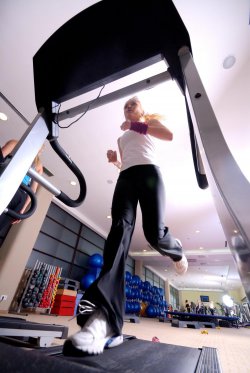Push It To The Limit
 By Jon Robinson
By Jon Robinson
Exercise expert Jon Robinson gives the lowdown on interval training.
If your idea of an ‘interval’ is letting off some slack and popping along to the nearest bar for a beverage, then you’ve come to the wrong place. Where we’re going for an interval, you’ll get down and dirty and if you’re not left sweating like a laowai barfly’s armpit by the end of it, then you may as well go home.
Let’s just clear up what we’re talking about. Interval training is an intense burst of exercise (an interval) followed by a less intense period (another interval) that is repeated several times. It’s an effective exercise as it raises the level of your anaerobic threshold, meaning that you can exercise at a much higher intensity without feeling like you are doing all that much. Interval training methods can be applied to resistance (muscle training); however, it’s when you’re performing cardio exercises that interval training really comes into its own. And as an additional benefit, it's an effective way to burn off that excess fat.
To the far right you see two example interval workouts of the same total duration of 180 seconds (intense in red and rest in blue). The shorter but more frequent bursts are much more physically demanding.
 These examples are set to 1:1 ratios (which is tough), but an easier workout would be 1:2 (10 seconds intense and 20 seconds rest) or 1:3 (10 seconds intense, 30 seconds rest). You could go the other way however, 1:0.5 is 10 seconds intense and 5 seconds rest, which is seriously tough when running, cycling or doing any form of cardio exercise.
These examples are set to 1:1 ratios (which is tough), but an easier workout would be 1:2 (10 seconds intense and 20 seconds rest) or 1:3 (10 seconds intense, 30 seconds rest). You could go the other way however, 1:0.5 is 10 seconds intense and 5 seconds rest, which is seriously tough when running, cycling or doing any form of cardio exercise.
Most people get interval training wrong the first few times and often miss the point. The aim is to get your heart rate as high as possible, therefore exercising in many bursts of short intervals as intensely as is safe to undertake. Challenging yourself and getting that heart rate up has countless health benefits, including off-setting T2 diabetes. But where interval training raises a challenge is that there’s no way of easing yourself in; setting the duration of the interval over ten seconds means pacing yourself, therefore not reaching the peaks.
Most cardio machines that you see in gyms, such as treadmills, ellipticals etc. have pre-set programs that determine the durations of activity and rest, and they are for the most part set incorrectly. For most programs on cardio machines, both the active and rest portions are too long, meaning that you will unconsciously pace yourself. Also the rest portions are not restful enough, but merely slower/easier versions of the activity. This is bad because firstly you won’t hit the heights required on the first interval, and also the lack of proper rest means that you won’t have enough juice in the tank to hit the heights on the next interval. In order to make the most of your time in the gym you need two things: many short but maximal bursts of activity followed by complete rest.
This is an essential factor in the amount of fat that you burn and 50 minutes is the ideal duration provided you are working hard. It helps to look at it this way: the more effort you put in within the ‘workout window’ between 8 minutes (when fat oxidation becomes effective) to 50 minutes, the more fat you will burn. Under 10 minutes isn’t going to even get the fat oxidation started effectively.
If you are training outside, shuttle runs in team sports are the perfect way to try out interval training! However, in the gym there are a lot more safety issues, particularly if you are exercising on a treadmill. There’s no time to stop/start the belt so you’ll have no choice but to hold onto the handrails and jump to the side if you find you haven’t got the juice!
Jon Robinson is the co-owner of Spin Shanghai (Rm A401, 525 Fahuazhen Lu, near Dingxi Lu. Tel 139 1804 4705). For in depth instructions on how to do these exercises properly, as well as other helpful tips on duration of exercise and routine guidance, check out his blog on www.makethisworkout.com
